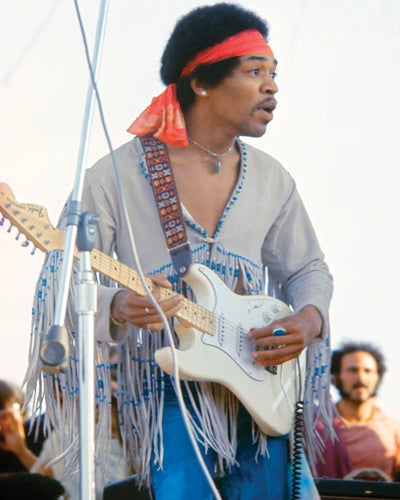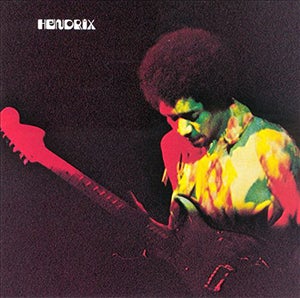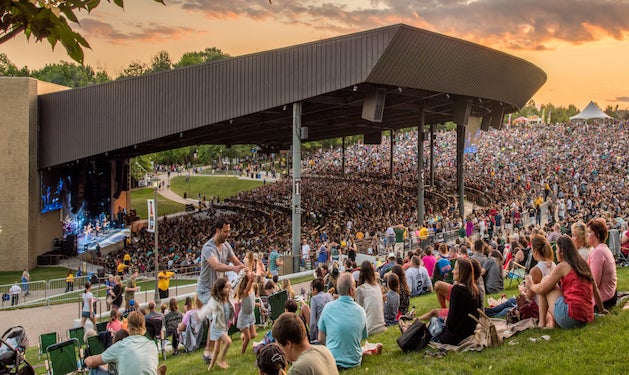Jimi Hendrix’s was the most anticipated Woodstock performance, but by the time he and his newly formed band, Gypsy Sun & Rainbows, started their two-hour set at 9:00 a.m. Monday morning, the half-million-person audience was down to roughly 40,000. Those who stayed for the festival finale witnessed one of the most memorable and legendary performances of the entire decade.
Celebrating the 50th anniversary of the Woodstock festival, August 1969–2019
Day Three, Performer Ten: Jimi Hendrix
Performed Monday morning, August 18, 9:00–11:15 am

Jimi Hendrix Band Members
- Jimi Hendrix: guitar, vocals
- Larry Lee: guitar, vocals
- Billy Cox: bass
- Juma Sultan: percussion
- Gerarde “Jerry” Valez: congas
- Mitch Mitchell: drums
Jimi Hendrix Woodstock Setlist
- Message To The Universe (Message To Love)
- Getting My Heart Back Together Again
- Spanish Castle Magic
- Red House
- Master Mind (feat. Larry Lee
- Lover Man (feat. Larry Lee)
- Foxy Lady
- Jam Back At The House (Beginning)
- Izabella
- Gypsy Woman/Aware Of Love
- Fire
- Voodoo Child (slight return)/Stepping Stone
- Star-Spangled Banner
- Purple Haze
- Woodstock Improvisation/Villanova Junction
- Hey Joe
Jimi Hendrix - The Early Years
Jimi Hendrix's story is well-known: he was born Johnny Allen Hendrix in Seattle, Washington on November 27, 1942, and his name was soon after changed by his parents to James Marshall Hendrix. By the time he’d reached his teenage years, Jimi had picked up an interest in music, and specifically in the guitar, spurred by the blues and R&B sounds of the day. Although his father initially refused to buy him a guitar, he found a ukulele at a house he was cleaning out and was able to persuade the woman who owned the instrument (which only had one string) to give it to him. Soon after, Jimi began learning early rock and roll songs on the single-string ukulele, and he graduated from this to his first acoustic guitar at the age of 15. He formed his first group, The Velvetones, in 1959, and his father was forced to buy him his first electric guitar so that Jimi could be heard above the other instruments.
In 1961, Jimi joined the U.S. Army (to avoid jail time for car theft) and became a paratrooper with the 101st Airborne in Fort Campbell, Kentucky. During his relatively brief stint in the military, Jimi met bassist Billy Cox and the pair began playing in bands on the base. A year after joining, he left the Army on a medical discharge and began playing with various acts on the southern Chitlin’ Circuit. 1964 saw Jimi make the move to New York City, which would become his home base for the next two years as he worked as a featured guitarist for acts like The Isley Brothers and Little Richard. In addition to this, Jimi began playing New York clubs with his own combo, Jimmy James and The Blue Flames.
A Legend is Discovered
While playing a gig with R&B vocalist Curtis Knight at New York’s Cheetah Club, Jimi was spotted by Linda Keith, who was then the girlfriend of Rolling Stones guitarist Keith Richard. This led to his eventual discovery by Chas Chandler, former bass player of The Animals who had decided to strike out on his own as a producer. He signed Jimi to a management contract, brought him to London and set up The Jimi Hendrix Experience, a power trio (modeled after British supergroup Cream), featuring bassist Noel Redding and drummer Mitch Mitchell. Jimi’s first single, a cover of Tim Rose’s “Hey Joe,” was an instant hit in England and, along with Jimi’s incredibly exciting stage act and next-level guitar skills, established him immediately as a major player on the British music scene.
More hits followed with the psychedelic anthem “Purple Haze” and “The Wind Cries Mary” before The Experience recorded their first Chandler-produced LP, Are You Experienced? Released in May 1967, this became an instant massive success and all-time classic album, eventually breaking Jimi in his native America as well. Before the album was issued stateside, The Jimi Hendrix Experience played their breakout gig in America at the Monterey International Pop Festival, where Jimi’s heroic guitar theatrics (including setting his guitar on fire before demolishing it) shocked, stunned, and delighted the very hip San Francisco crowd.

Hendrix Moves to the Catskills
This began a period of heavy touring and recording for The Jimi Hendrix Experience across America and Europe. Their second album, Axis: Bold As Love was released in December 1967 and was another huge commercial success. A third album, Electric Ladyland, expanded the group’s sound further and was again hugely successful. However, the stress of constant activity and personal tensions blew the group apart after an appearance at the Denver Pop Festival in June 1969. Now on his own, Hendrix moved to Shokan, New York (a small village near the town of Woodstock in the Catskills) to plot his next move. While there, his management negotiated an $18,000 ($122,000 in 2019 dollars) offer to play at the Woodstock festival in August, with Hendrix receiving the highest payment of any artist booked for the festival.
A Performance for the History Books
By August of 1969, Hendrix’s career was in a major state of flux. Holed up at his rented house in Shokan, he assembled a new group to play at Woodstock, which he named Gypsy Sun and Rainbows. This featured Jimi Hendrix Experience drummer Mitch Mitchell alongside two local Woodstock percussionists, Juma Sultan and Jerry Velez. The lineup was rounded off with two of Hendrix’s buddies from his days in the U.S. military, guitarist Larry Lee and rock-solid bassist Billy Cox. They convened for a brief but intense series of rehearsals in Woodstock before heading out to White Lake for Hendrix’s headlining gig.
As the sun rose higher in the sky on Monday morning, it was now time to bring the Woodstock Music & Art Fair to a close. The man chosen to cap the event was Jimi Hendrix, who got the honor after festival promoter Michael Lang tried and failed to book cowboy legend Roy Rogers, whose “Happy Trails” may well have been a poignant (if somewhat bizarre) closing number for that tumultuous weekend. Hendrix had been scheduled to climax Woodstock’s final evening around midnight, but scheduling delays meant that he did not take the stage until 9:00 a.m. on Monday morning.
By this time, the crowd had largely dispersed and returned to their regularly scheduled lives (although there was a certain glow to each and every one of them). About 40,000 people stayed to watch Hendrix and his new group get it on, a tenth of the total attendance of the festival but enough to intimidate Hendrix and his band. Nonetheless, Hendrix looked remarkably relaxed and composed as he walked to the microphone and casually remarked: “I see that we meet again!”
After correcting Chip Monck (who had introduced the group as The Jimi Hendrix Experience), Jimi and his comrades launched into a new song, “Message To The Universe” (later titled “Message To Love” and later released on the live album Band of Gypsys in 1970. The group worked fairly well together, with a full sound dominated by Hendrix’s white Fender Stratocaster. Another unfamiliar song followed with “Getting My Heart Back Together,” a song that would go unreleased on an album during Hendrix’s lifetime but which had been a regular live number for the past several months. Retreating to the familiar, Hendrix pulled out an exuberant version of “Spanish Castle Magic” from the 1967 album Axis: Bold As Love, in which he traded off solos with Larry Lee and even gave the spotlight over to Mitch Mitchell for a brief drum break.
Hendrix’s beloved slow blues “Red House” followed. It had been issued on U.K. pressings of his debut album Are You Experienced? in 1967 but had only just been released in the U.S. the previous month on the compilation, Smash Hits. Larry Lee was given a lengthy guitar solo, though unfortunately, his Les Paul suffered from major tuning and intonation issues which he would never quite recover from for the entirety of the performance. Larry was then given a chance to take a lead vocal with his self-penned ballad “Master Mind”.
Feeling the need to take things up a notch, Hendrix abruptly launched into “Lover Man,” another unreleased tune that would be familiar to Experience audience veterans, as Hendrix had been playing it live for the previous two years. With the crowd yelling for more familiar material, Jimi delivered the goods with a searing rendition of “Foxey Lady” from his first album, pulling out his catalog of crowd-pleasing bumpin’ and grindin’ guitar tricks. The set continued with two brand new numbers—“Beginning” (aka “Jam Back At The House”) was a monstrous and complex riff-based instrumental that featured another drum solo from Mitchell, while the anti-war anthem “Izabella” grooved along in a most appealing and offbeat manner, giving the audience a glimpse at the progressive fusion Hendrix envisioned for his future work.
It was now ballad time with Larry Lee again, as he got soulful on a medley of two Curtis Mayfield and The Impressions songs, “Gypsy Woman” and “Aware Of Love.” By this time, the crowd was still shouting out requests for various oldies, and Jimi obliged them with a rousing “Fire” from his first album. It was now time to take it on home; for this purpose, Hendrix lit into his standard closing number “Voodoo Child (Slight Return)” from his 1968 album Electric Ladyland. This extended into a jam with Hendrix trading off solos with Larry Lee; as this wound down he advised the audience that “you could leave if you want to, we’re just jamming, that’s all.”
This wound down to the crashing final chord and then, suddenly and without warning the band, Hendrix hit upon the opening notes to the U.S. national anthem “The Star-Spangled Banner.” The band tried to follow Hendrix’s lead briefly but then wisely chose to layout as he created magic. His masterful instrumental rendition of the anthem managed to convey the feeling of turmoil that gripped America at the time; nightmare visions of war and destruction swept over the crowd before he brought it back to earth with a peaceful reading of the final lines of the piece. This was a truly astonishing performance and one that would become one of the most enduring of all Woodstock moments and memories.
But Jimi Hendrix was not finished. To the delight of the crowd, he proceeded non-stop into the classic “Purple Haze” from his first album, delivering a mighty rendition of this golden oldie which was enhanced by the obvious magic he had just created. This settled into a lengthy instrumental improvisation, with Jimi running unaccompanied through a variety of riffs and styles. Finally, he brought the main set to a close with “Villanova Junction,” a slow and mournful instrumental blues that seemed like a requiem for the entire weekend. With that, Jimi left the stage with a simple “thank you.”
The crowd wasted no time in demanding more, however, and Hendrix quickly returned. Although he had wanted to play another new song, “Valleys of Neptune,” he gave in to the crowd’s demand for the familiar and closed out his performance, and Woodstock as a whole, with a strong rendition of his first single “Hey Joe,” sounding somewhat incongruous in light of what had come before it. With that, an exhausted Chip Monck bade the crowd farewell with a sweet, “Ladies and gentlemen, thank you so very much. It’s been a delight seeing you. May we wish you anything that the person next to you wishes for you. Good wishes, a good day, and a good life. Thank you.” The denizens of Woodstock Nation returned home transformed, well aware of the cultural revolution that they had helped create.
Post-Woodstock
After Woodstock, Jimi Hendrix became bigger than ever, initially forming a short-lived R&B-rooted band with Billy Cox and drummer Buddy Miles that he called Band of Gypsys. Their lone album was a self-titled live effort released in March 1970. Shortly thereafter, he went back out on the road with a reconstituted Jimi Hendrix Experience featuring Mitch Mitchell and Billy Cox. Jimi Hendrix died of asphyxia from a barbiturate overdose on September 18, 1970, leaving behind an incomplete fourth studio album, parts of which would be released as The Cry of Love in March 1971.

Gypsy Sun & Rainbows - Where Are They Now?
As for the other musicians who made up the Gypsy Sun & Rainbows lineup that played at Woodstock, percussionist Gerardo Velez was a founding member of the fusion group Spyro Gyra and continues to play music in the New York City area. Percussionist Juma Sultan also continues to play and still resides in Woodstock, New York. Guitarist Larry Lee retired from music shortly after the festival and died of cancer in 2007. Bassist Billy Cox tours yearly with the official Hendrix tribute show, Experience Hendrix, and lives in Nashville, Tennessee. Original Jimi Hendrix Experience drummer Mitch Mitchell died in Portland, Oregon of natural causes in 2008, five days after finishing a tour with Experience Hendrix.
—Wade Lawrence & Scott Parker
Peace, Love, and Music.
